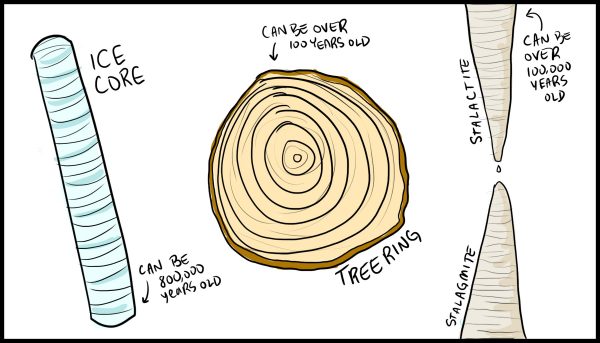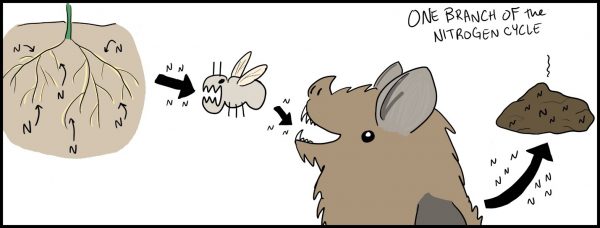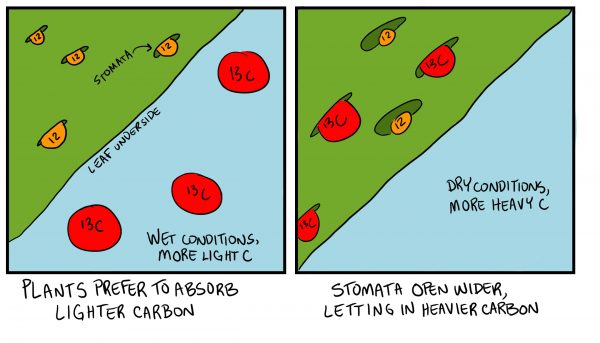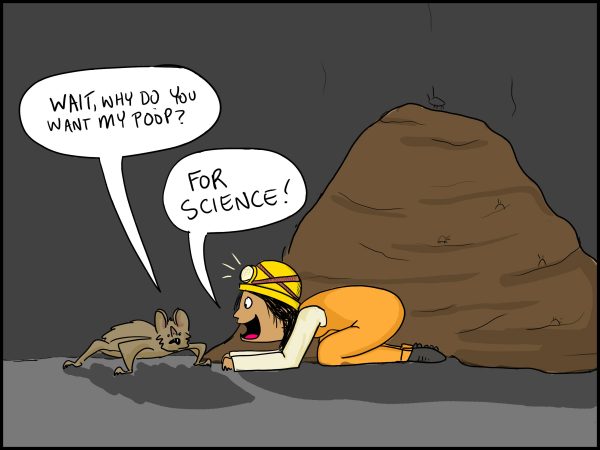30 October 2017
Drawn to Geoscience: Bat Poop Is Helping Scientists Study the Past
Posted by Olivia Ambrogio
This post is part of our Drawn to Geoscience series where our own JoAnna Wendel creates (and explains her process for) comics of geoscience research.
Animal poop holds many secrets. It can reveal where an animal lived, what it ate, and maybe even what the weather was like.
Recently, some scientists at the University of South Florida decided to grind up some bat poop–which is referred to as “guano”–to see if it could provide an accurate record of rainy and dry periods.
Guano is attractive to scientists for many reasons. For one, it’s everywhere. Wherever there’s a cave with bats, there’s guano. Mountains of it, sometimes tens of feet tall. The piles are often infested with cockroaches and other insects and bacteria that can be toxic to visiting humans. And because the guano is stratified–meaning the older guano is on the bottom and younger bottom on top–it could offer a climate snapshot for the region where it’s found.

Scientists already study ice cores, tree rings, and cave formations like stalactites and stalagmites to learn about past climates, which is important for studying future climate. Scientists find these structures, which all build up over time like piles of bat guano, all over the world at the poles, in forests, and deep within caves. Molecules containing carbon and oxygen within these structures preserve a signature of the past.

Although guano holds carbon, scientists don’t find much oxygen in it. But what guano does have is nitrogen.
But how does the nitrogen get there? Nitrogen molecules constantly cycle through the atmosphere. They get processed by microbes in soil, then get absorbed by plants, which get eaten by insects, which are gobbled by bats. The bats then gleefully poop out the nitrogen-rich guano onto their living room–I mean cave–floor.

The researchers wanted to know if the ratio of different nitrogen isotopes was preserved throughout this cycle into the guano. Isotopes are atoms that have a different number of neutrons, and it’s the ratio of different isotopes that help scientists study. The researchers specifically looked at 14-Nitrogen (which means it has 7 protons and 7 neutrons) and compared it with its heavier cousin, 15-N (7 protons and 8 neutrons).
First, the researchers took the top few centimeters of a 1.5 meter-long core of guano. They studied the ratios of nitrogen-14 to its heavier cousin, 15-N. They compared this data with local precipitation data from the past few months.
The researchers found that the sections of the core with a higher ratio of 15-N correlated with rainy periods. This may be because the lighter nitrogen molecules get washed away, so plants end up absorbing more of the heavy isotope.
In drier periods, the researchers found a higher ratio of 14-N, probably because when there’s enough nitrogen around, plants preferentially absorb the lighter isotope.

Then they applied what they found to the entire length of the 1.5 meter-long core. The scientists already knew the wet/dry patterns based on carbon its isotopes. Plants prefer to absorb the lighter carbon isotope, 12-C, so in wet periods, the core preserves a higher ratio of 12-C. In dry periods, the plant widens its tiny openings called stomata, which it uses to absorb carbon. When the stomata open wider, more 13-C can pass through–which leaves a higher ratio of 13-C in the guano.

It turned out that the wet/dry patterns the researchers found with nitrogen matched the pattern already found with carbon! That means bat guano could serve as another way for scientists to study the past.

About the Comic: Everyone Loves Stories About Poop
I knew the minute I discovered this story it needed to be a comic. It has everything! Climate change, mystery, intrigue, bats, and most of all: Poop. Who doesn’t like a good poop story?
Deciding how to format this comic took a lot of thinking. There are so many layers (though, not of literal poop, thank god) to explain along with the narrative of what the scientists did.
There’s explaining how bat guano preserves carbon and nitrogen, how that carbon and nitrogen end up in the poop, and how the different concentrations of carbon and nitrogen isotopes represent wet or dry weather conditions. In the end, I decided to break up the comic and include more text with panels interspersed.
In this case, the panel drawings are used to illustrate points rather than to tell the whole story. Representing stratification isn’t too hard—it’s just a matter of labeling the old poop at the bottom of a poop pile versus the new poop at the top of the poop pile.
Drawing the portion of the nitrogen cycle that’s pertinent to this story was a bit hard because I simplified it a lot. I needed to show that plants soak of nitrogen, bugs eat those plants, bats eat those bugs and then those bats poop out nitrogen-rich guano. There are many other steps to the nitrogen cycle (and I didn’t even draw the entire cycle) but for the purposes of this story, the illustration works to show how nitrogen gets from the environment into guano.
Then, in the end, it’s just fun to anthropomorphize. I love to image bats hanging in caves thinking “Why are these humans so obsessed with my poop?”
—JoAnna Wendel is an Eos Staff Writer. Find her @JoAnnaScience.










 The Plainspoken Scientist is the science communication blog of AGU’s Sharing Science program. With this blog, we wish to showcase creative and effective science communication via multiple mediums and modes.
The Plainspoken Scientist is the science communication blog of AGU’s Sharing Science program. With this blog, we wish to showcase creative and effective science communication via multiple mediums and modes.